- Home
- /
- Top Stories
- /
- The Impact Of SC's RTI Judgment On...
The Impact Of SC's RTI Judgment On Collegium Decisions
Manu Sebastian
23 Nov 2019 8:59 AM IST
A Constitution Bench of the Supreme Court held last week that the office of the Chief Justice of India is amenable to the Right to Information Act.Since the judgment is generally welcomed as progressive, it is pertinent to understand its impact on collegium resolutions on judicial appointments - often called the 'best kept secret in the country'.The judgment - which came in appeals which had...
Next Story



